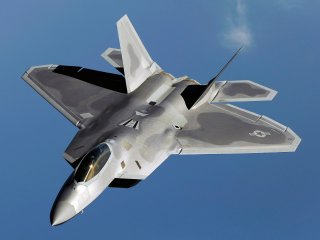The F-22 and F-35 Are America's Best Fighters (but They Can't Communicate)
The F-35 Lightning II jet can’t communicate all that well with its little brother the F-22 Raptor.
The Air Force plans to start fixing the problem by 2021, according to Bloomberg. It will probably cost a fortune, so if you have the means, it may be good to check out some Lockheed stock.
The F-35 Lightning II jet can’t communicate all that well with its little brother the F-22 Raptor. Because of course it can’t.
Just like a government-built round peg that’s supposed to go into a square hole, the F-22’s communications systems can’t send its “most sensitive data” to other planes besides other F-22s since they are different from everything else, including the F-35, according to Air Force Magazine.
For now, F-22 pilots can only receive data from F-35 pilots and talk to them on the radio, but they can’t send data back, severely limiting the Lightning’s much-hyped role as being a “quarterback” on the battlefield.
Here’s how Air Force Magazine describes it:
The situation wasn’t brought about by negligence. In developing the F-22—and later, the F-35—designers needed to preserve the jets’ stealth against rapidly evolving adversaries. Standard radio emissions would reveal their locations, which meant devising ways the low-observable fighters could talk to each other without giving away their position. Both jets have what are called “low probability of detection/intercept” communications gear to stay hidden. The F-35’s system—because it was developed 10 years after the F-22’s—takes a different approach.
The F-35 can talk to just about everything and fuse data received from other fifth-generation and fourth-generation aircraft, since it’s outfitted with two different communications systems. But the F-22 has a communications system built only for itself, called the Intra-Flight Data Link.
F-22s were supposed to get the upgraded Multifunction Advanced Data Link that the F-35 has, but surprise, that was canceled five years ago due to cost.
“There’s a lot of improvements that could have been done and should have been done 15 years ago,” David Rockwell, a senior defense electronics analyst with Teal Group, told Bloomberg. “The Air Force postponed a lot of things for [the] F-22.”
The Air Force plans to start fixing the problem by 2021, according to Bloomberg. It will probably cost a fortune, so if you have the means, it may be good to check out some Lockheed stock.
Paul Szoldra is a columnist for Task & Purpose. His past bylines include Business Insider, We Are The Mighty, and Duffel Blog, which he founded in 2012. He served as a Marine infantryman in Afghanistan. Follow Paul Szoldra on Twitter @paulszoldra.
This article originally appeared at Task & Purpose. Follow Task & Purpose on Twitter.
More Articles from Task & Purpose:
- 7 Veteran-Friendly Manufacturers That Are Hiring
- The 6 Types Of Contractors You Encounter Overseas
- Here’s How Marines Fared On The New Physical Fitness Test
Image: Wikimedia Commons

